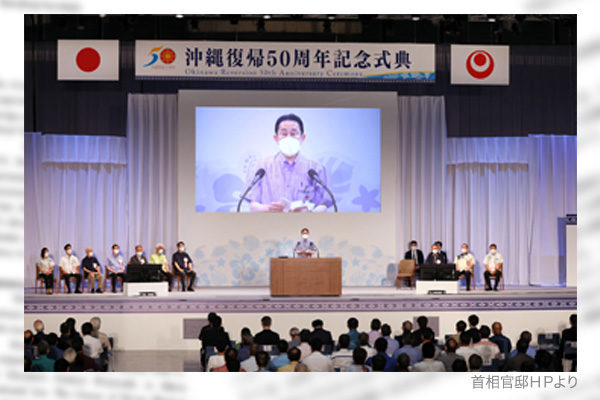While events to mark the 50th anniversary of Okinawa’s reversion to Japan took place at various locations in Japan these days, I sensed little rejoicing from the bottom of heart expressed by Okinawan people. A typical comment came from writer Kiyoshi Nakamura, whose parents were from Okinawa, on the Asahi Shimbun newspaper on May 14: “Okinawa is becoming a prefecture or a region of Japan. I don’t know if Okinawa will have a bright future.” The comment was headlined “Postwar ends as Japanization proceeds.”
400-year resentment
I lived in Naha City for over one year from 1969 to 1970 just before Okinawa’s reversion to Japan. Throughout Okinawa Island, people with red headbands and sashes were loudly calling for Okinawa’s “comprehensive reversion” to Japan. During the stay, I heard about the confrontation between yamatonchu (mainlander Japanese) and uchinanchu (Okinawans).
Not a few newspaper articles and television feature programs then explained Okinawan people were mentally scarred by the fact that one of every four people died in the Battle of Okinawa. But most local historians pointed out a much longer history.
They said Okinawans experienced a sea change three times. In the first change, military operations by the Satsuma Domain at the southern tip of Japanese mainland in 1609 led Okinawa, then called the Ryukyu Kingdom, to become an unusual tributary nation to both China and Satsuma. In the second change, the kingdom was abolished to become the Ryukyu Domain, and then Okinawa Prefecture in the wake of the Meiji Restoration. The Ryukyu King was given an official residence in Tokyo without a homecoming visit to Okinawa. In the third change, Okinawa fell victim to the war Japan waged against the United States, the historians said. As a mainlander Japanese, I wanted to point out that not only Okinawa but also Tokyo and other major Japanese cities were bombed during the war, and Hiroshima and Nagasaki were particularly destroyed by atomic bombs. Had I begun arguing, I would have faced an emotional entanglement with Okinawans.
Before calls for Okinawa’s reversion to Japan grew, Okinawa launched a movement to hoist the Japanese national flag. As the Japanese government led by Prime Minister Eisaku Sato kicked off negotiations with the U.S. administration of President Richard Nixon on Okinawa’s reversion to Japan, the Rising Sun flags disappeared, replaced by red headbands and sashes. In November 1969 when a Japan-U.S. communique on Okinawa’s reversion was announced, demands for Okinawa’s immediate, unconditional and comprehensive reversion and for Ryukyu’s independence were rising. For Tokyo, they were unfeasible demands.
That the Nixon administration accepted the removal of nuclear weapons from Okinawa before the reversion became a signal of a U.S. wish to improve relations with China, leading to Nixon’s historic visit to China. Does Japan understand today that China was most pleased with the removal of nuclear weapons from Okinawa?
Understand viewpoints of Tokyo and Naha
Issues related to Okinawa including that of the planned relocation of the Futenma U.S. Marine Air Station to Henoko are complicated. But solutions are just ordinary. Naha and Tokyo have no choice but to understand each other’s viewpoints and stances. When Japanese mainland companies were to expand into Okinawa in the wake of the Okinawa reversion agreement, some of them tried to set up a “Japanese association in Okinawa” in a scandalous movement. A half century after the reversion, fewer people may be discussing confrontation between yamatonchu and uchinanchu. Both are Japanese. While respecting Okinawan culture, Tokyo and Naha would hopefully enter a new age when both of them look carefully at the international situation.
Tadae Takubo is Vice President, Japan Institute for National Fundamentals, and a professor emeritus at Kyorin University.


